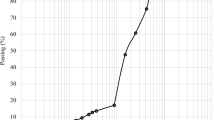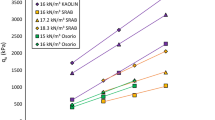Abstract
Soil cement as pavement base has been used in practice since 1915 due to its effectiveness in preventing pumping of the subgrade soils and its relatively high strength. In this research, the factors affecting the strength of cement-sand were investigated based on laboratory compaction tests and unconfined compression tests. The test results showed that the dry density, moisture content (w), water to cement ratio (w/c), initial void ratio (e ini ), and cement content (C w ) are the main controlling factors in the behavior of cementsand. A simple empirical correlation method is proposed to estimate the unconfined compressive strength of the cement-sand based on cement content, initial moisture content, and water to cement ratio. The tube suction tests were also performed in an effort to evaluate the water susceptibility of cement-sand, as the strength of cement soil can be affected by the soaking condition at field. The tube suction tests showed that the cement-sand can be classified as good quality base material based on the dielectric value.
Similar content being viewed by others
References
Abdulla, A. and Kiousis, P. (1997a). “Behavior of cemented sands — I. Testing.” International Journal for Numerical and Analytical Methods in Geomechanics, Vol. 21, pp. 533–547.
Abdulla, A. and Kiousis, P. (1997b). “Behavior of cemented sands — II. Modeling.” International Journal for Numerical and Analytical Methods in Geomechanics, Vol. 21, pp. 549–568.
ACI Committee 230 (1990). “State-of-the-art report on soil cement.” ACI Materials Journal, American Concrete Institute, Vol. 87, No. 4, pp. 395–417.
American Society for Testing and Materials. (2000). ASTM D 1633. Standard Test Methods for Compressive Strength of Molded Soil-Cement Cylinders, Philadelphia, PA.
American Society for Testing and Materials. (2007). ASTM D 698. Standard Test Methods for Laboratory Compaction Characteristics of Soil Using Standard Effort (12,400 ft-lbf/ft 3 (600 kN-m/m 3 )), Philadelphia, PA.
Barbu, B. and Scullion, T. (2006). Repeatability and Reproducibility Study for Tube Suction Test. FHWA/TX-06/5-4114-01-1, Texas Transportation Institute.
Bergado, D.T., Ruenkrairergsa, T., Taesiri, Y., and Balasubramaniam, A.S. (1999). “Deep soil mixing to reduce embankment settlement.” Ground Improvement Journal, Vol. 3, No. 3, pp. 145–162.
Chun, B.S. and Kim, J.C. (2001). “A study of soil cement properties by using soilcrete stabilizer.” Journal of Korean Geo-Environmental Society, Vol. 2 No. 4, pp. 73–81.
Guthrie, W., Sebesta, S., and Scullion, T. (2002). Selecting Optimum Cement Contents for Stabilizing Aggregate Base Materials, FHWA/TX-05/7-4920-2, Texas Transportation Institute.
Haeri, S., Hosseini, S., Toll, D., and Yasrebi, S. (2005). “The behavior of an artificially cemented sandy gravel.” Geotechnical and Geological Engineering, Vol. 23, pp. 537–560.
Kim, B.I., Wee, S.H., Lee, S.H., and Kim, Y.U. (2003). “Strength characteristics of soil-cement mixed with inorganic solidification liquid.” Journal of the KSCE, KSCE, Vol. 23,Issue 3C, pp. 135–141.
Kim, J.H., Won, J.Y. Kim, S.P., and Chang, P.W. (2004). “Phase changes of soil-cement mixture using fall cone and heat of hydration.” Journal of the Korean Geotechnical Society, Vol. 20,Issue 9, pp. 25–32.
Lade, P.V., Liggio, C.D., and Yamamuro, J.A. (1998). “Effects of nonplastic fines on minimum and maximum void ratios of sand.” Geotechnical Testing Journal, ASTM, Vol. 21, No. 4, pp. 336–347.
Lee, S., Lee, K.H., Yi, C.T., and Jung, D.S. (2001). “A constitutive model for cemented clay in a critical state framework.” Journal of the Korean Geotechnical Society, Vol. 17,Issue 1, pp. 119–129.
Lorenzo, G. and Bergado, D. (2004). “Fundamental parameters of cement-admixed clay-new approach.” Journal of Geotechnical and Geoenvironmental Engineering, ASCE, Volume 130,Issue 10, pp. 1042–1050.
Mindess, S., Young, J., and Darwin, D. (2002). Concrete, 2 ed., Prentice Hall.
Miura, N., Horpibulsok, S., and Nagaraj, T. (2001). “Engineering behavior of cement stabilized clay at high water content.” Soils and Foundations, Vol. 41, No. 5, pp. 33–45.
Mohammad, L., Raghavandra, A., and Huang, B. (2000). “Laboratory performance evaluation of cement-stabilized soil base mixtures.” Transportation Research Record, No. 1721, TRB, National Research Council, Washington, D.C., pp. 19–28.
Park, S.S., Kim, Y.S., and Lee, J.C. (2007). “Unconfined compressive strength of fiber-reinforced cemented sands by fiber reinforcement form.” Journal of the Korean Geotechnical Society, Vol. 23,Issue 8, pp. 159–169.
Stavridakis, E. (2005). “Evaluation of engineering and cement-stabilization parameters of clayey-sand mixtures under soaked conditions.” Geotechnical and Geological Engineering, Vol. 23, pp. 635–655.
Zhang, Z. and Tao, M. (2007). “Build reliable cement-treated subgrade layer.” The Proceedings of 7th International Conference of Chinese Transportation Professionals, May 21–22, 2007, Shanghai, China, pp. 79–90.
Author information
Authors and Affiliations
Corresponding author
Rights and permissions
About this article
Cite this article
Yoon, S., Abu-Farsakh, M. Laboratory investigation on the strength characteristics of cement-sand as base material. KSCE J Civ Eng 13, 15–22 (2009). https://doi.org/10.1007/s12205-009-0015-x
Received:
Revised:
Accepted:
Published:
Issue Date:
DOI: https://doi.org/10.1007/s12205-009-0015-x




